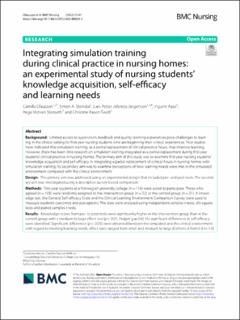| dc.contributor.author | Olaussen, Camilla | |
| dc.contributor.author | Steindal, Simen Alexander | |
| dc.contributor.author | Jelsness-Jørgensen, Lars-Petter | |
| dc.contributor.author | Aase, Ingunn | |
| dc.contributor.author | Stenseth, Hege Vistven | |
| dc.contributor.author | Tvedt, Christine Raaen | |
| dc.date.accessioned | 2022-06-17T08:24:11Z | |
| dc.date.available | 2022-06-17T08:24:11Z | |
| dc.date.created | 2022-02-11T14:58:45Z | |
| dc.date.issued | 2022 | |
| dc.identifier.issn | 1472-6955 | |
| dc.identifier.uri | https://hdl.handle.net/11250/2999235 | |
| dc.description.abstract | Background Limited access to supervision, feedback and quality learning experiences pose challenges to learning in the clinical setting for first-year nursing students who are beginning their clinical experiences. Prior studies have indicated that simulation training, as a partial replacement of clinical practice hours, may improve learning. However, there has been little research on simulation training integrated as a partial replacement during first-year students’ clinical practice in nursing homes. The primary aim of this study was to examine first-year nursing students’ knowledge acquisition and self-efficacy in integrating a partial replacement of clinical hours in nursing homes with simulation training. Its secondary aim was to examine perceptions of how learning needs were met in the simulated environment compared with the clinical environment. Design The primary aim was addressed using an experimental design that included pre- and post-tests. The secondary aim was investigated using a descriptive survey-based comparison. Methods First-year students at a Norwegian university college (n = 116) were asked to participate. Those who agreed (n = 103) were randomly assigned to the intervention group (n = 52) or the control group (n = 51). A knowledge test, the General Self-efficacy Scale and the Clinical Learning Environment Comparison Survey were used to measure students’ outcomes and perceptions. The data were analysed using independent samples t-tests, chi-square tests and paired samples t-tests. Results Knowledge scores from pre- to post-tests were significantly higher in the intervention group than in the control group with a medium to large effect size (p < 0.01, Hedges’ g = 0.6). No significant differences in self-efficacy were identified. Significant differences (p < 0.05) were observed between the simulated and the clinical environment with regard to meeting learning needs; effect sizes ranged from small and medium to large (Cohen’s d from 0.3 to 1.0). Conclusion Integrating the partial replacement of clinical hours in nursing homes with simulation training for first-year nursing students was positively associated with knowledge acquisition and meeting learning needs. These findings are promising with regard to simulation as a viable partial replacement for traditional clinical practice in nursing homes to improve learning. | en_US |
| dc.language.iso | eng | en_US |
| dc.rights | Navngivelse 4.0 Internasjonal | * |
| dc.rights.uri | http://creativecommons.org/licenses/by/4.0/deed.no | * |
| dc.subject | Sykepleiestudenter | en_US |
| dc.subject | Sykehjem | en_US |
| dc.subject | Simuleringstrening | en_US |
| dc.title | Integrating simulation training during clinical practice in nursing homes: An experimental study of nursing students´ knowledge acquisition, self-efficacy and learning needs | en_US |
| dc.title.alternative | Integrating simulation training during clinical practice in nursing homes: An experimental study of nursing students´ knowledge acquisition, self-efficacy and learning needs | en_US |
| dc.type | Peer reviewed | en_US |
| dc.type | Journal article | en_US |
| dc.description.version | publishedVersion | en_US |
| dc.source.journal | BMC Nursing | en_US |
| dc.identifier.doi | 10.1186/s12912-022-00824-2 | |
| dc.identifier.cristin | 2000604 | |
| dc.relation.project | SHARE - Centre for Resilience in Healthcare: 5091 | en_US |
| cristin.ispublished | true | |
| cristin.fulltext | original | |
| cristin.qualitycode | 1 | |

